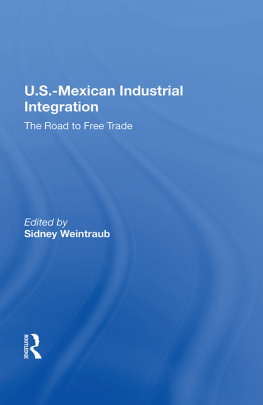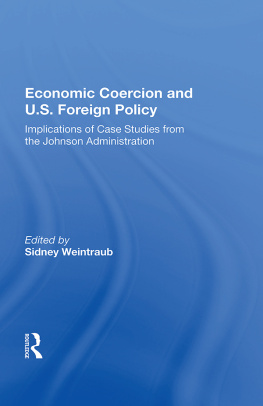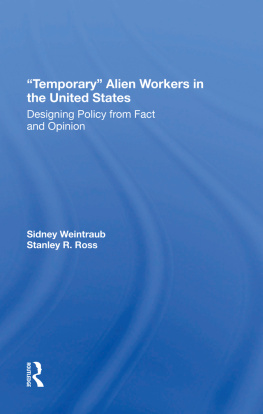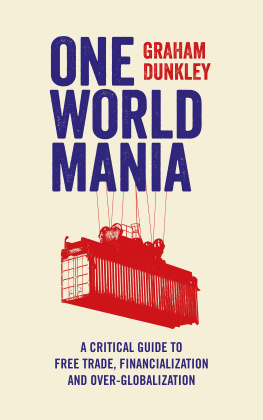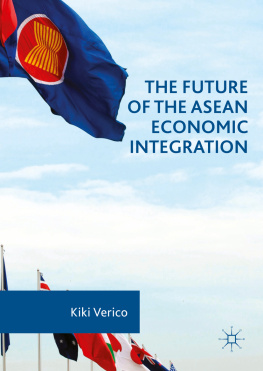U.S.-Mexican Industrial Integration
First published 1991 by Westview Press
Published 2019 by Routledge
52 Vanderbilt Avenue, New York, NY 10017
2 Park Square, Milton Park, Abingdon, Oxon OX14 4RN
Routledge is an imprint of the Taylor & Francis Group, an informa business
Copyright 1991 by Taylor & Francis
All rights reserved. No part of this publication may be reproduced or transmitted in any form or by any means, electronic or mechanical, including photocopy, recording, or any information storage and retrieval system, without permission in writing from the publisher.
Notice:
Product or corporate names may be trademarks or registered trademarks, and are used only for identification and explanation without intent to infringe.
Library of Congress Cataloging-in-Publication Data
U.S.-Mexican industrial integration edited by Sidney Weintraub, Luis
Rubio F., and Alan D. Jones.
p. cm.
1. United StatesForeign economic relationsMexico. 2. Mexico
Foreign economic relationsUnited States. 3. United States
Industries. 4. MexicoIndustries. 5. North AmericaEconomic
integration. I. Weintraub, Sidney, 1922 . II. Rubio F., Luis
III. Jones, Alan D. (Alan Dennis), 1952.
HF1456.5.M6U19 1991
337.72073dc20
9044541
CIP
ISBN 13: 978-0-367-21276-6 (hbk)
Contents
, Rogelio Ramrez de la O
, Clark W. Reynolds
, Sidney Weintraub
, Luis Rubio F.
, Marc E. Maartens
, Florencio Lpez-de-Silanes
, Benito Bucay F.
, Rina Quijada
, Robert M. Sherwood
, Enrique Gruner
, Ovidio Botella C., Enrique Garca C., and Jos Giral B.
, Stephen L. Lande
, Donald R. Lyman
, Lloyd E. Slater
, Jos Carlos Alvarez Rivero and Herbert Weinstein
, Roberto A. Snchez
, C. Richard Bath
We gratefully acknowledge the invaluable cooperation of many individuals and organizations on this project.
Without the assistance of the Houston Advanced Research Centers Center for Growth Studies this project would not have been possible. HARC, a Texas research consortium, sponsored a December 1989 conference on industrial linkages between Mexico and the United States that involved government officials, business leaders, and scholars from across the United States and Mexico. This binational conference, which led to the production of this volume, was the first to assess economic cooperation and industrial integration between the two nations from the perspective of six specific industries: automobiles, computers, food processing, petrochemicals, pharmaceuticals, and textiles and apparel. Most of the authors come from the industries themselves. A seventh section has been added to the volume analyzing the environmental impact of industrial integration.
The conference timing was excellent, coming shortly before the joint announcement of Presidents Carlos Salinas de Gortari and George Bush of their intention not only to negotiate a free trade agreement, but also to place top priority on such negotiations. The conference also came at a time when policymakers began discussing the U.S.-Mexican trade relationship in the context of achieving cost-effective production strategies that will allow the two nations to compete effectively with apan, other Asian countries, and Europe.
In addition to the assistance we received from HARC, we also received valuable help from the Centro de Investigacin para el Desarrollo and the Consejo Nacional de Poblacin, both of Mexico City.
We are also grateful to the Hewlett Foundation, the Commission for the Study of International Migration and Cooperative Economic Development, the National Science Foundation, the U.S. Department of Commerces Economic Development Administration, the Alfred P. Sloan Foundation, the Program for U.S.-Mexico Policy Studies of the Lyndon B. Johnson School of Public Affairs at the University of Texas at Austin, Arthur Andersen & Co., the law firm of Vinson & Elkins, the Harris and Eliza Kempner Fund, and Council of the Americas, which provided either financial assistance or advice, or both.
We would also like to thank Lisa Chemin of the Windmill Company and Marykay Scott, Spencer Carr, and Lynn Arts of Westview Press for their valuable assistance.
Sidney Weintraub
Special Acknowledgment
This book would never have been completed without the contribution of Jan Rich of the Lyndon B. Johnson School of Public Affairs at the University of Texas at Austin. Her main contribution was to put much murky English into readable form and to translate chapters originally in Spanish into English. She was in frequent contact with authors to get their acceptances of editing changesa sometimes frustrating task. She obtained permission to use copyrighted material where this was necessary. In sum, she was the perfect research associate.
S.W.
One
Economic Outlook in the 1990s
Rogelio Ramrez de la O
Mexico is at a turning point in its development strategy following decades of substantial government intervention in the economic system which, not surprisingly, culminated in the 1982 crisis. During the administration of President Miguel de la Madrid (19831988), the government launched many economic reforms that changed the development strategy. The new strategy is not free from contradictions, such as the generation of current account deficits combined with the maintenance of restrictions and a complex set of regulations on foreign direct investment; or the liberalization of foreign trade combined with failure to introduce new labor legislation enabling Mexican industry to compete internationally. Economic reform, once set in motion, calls for ever expanding reform, particularly when the economy needs foreign resources; Mexicos laws and institutions are not yet sufficiently open to foreign equity capital. But even with an open trade and investment regime, which Mexico does not yet have, the challenges involved in overcoming the crisis of the 1980s are still enormous.
Distortions and Crisis
During the 1920s and 1930s, following the Revolution, Mexico underwent a period of reconstruction. This period provided the government with an opportunity to forge a new political alliance among the various revolutionary factions. Central to the new regime was the strong presence of the state in the economy and the pursuit of the public interest as defined in Article 27 of the new Constitution.
The 1930s saw the first wave of economic nationalism and state intervention focused around the new regime. This was preceded by the founding of the Partido Nacional Revolucionario (PNR), which later was transformed into the Partido Revolucionario Institucional (PRI). The PRI was organized along corporatist lines and became the self-appointed heir to the Revolution. From that point the management of the economy and the promotion of economic development would be linked to single political party rule.
Such a monolithic system created its own informal balance. The Alemn administration (19461952) saw correctly that a strong private sector was necessary for post-war industrialization. This was based on import substituting industrialization (ISI) and on large external economies facilitated by public investment in infrastructure. A notion of complementarity between public and private investment was used, with no limits placed on foreign participation in private enterprise other than those explicit in the Constitution.

